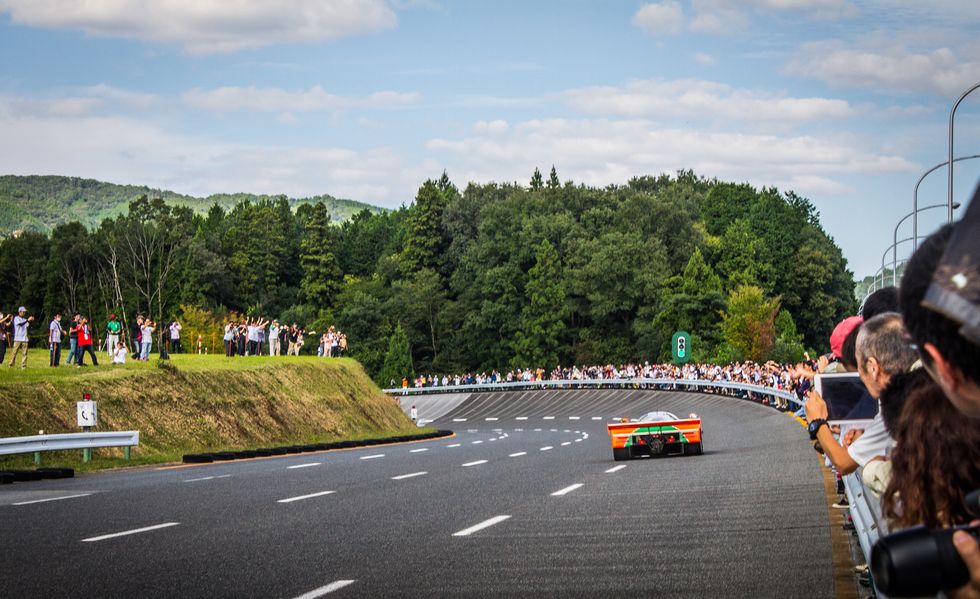Mazda 787B That Won Le Mans in 1991 Returned This Year, Fabulous Noise and All

The Mazda 787B was the first Japanese car to win Le Mans, taking a hard-fought victory in 1991.
After being immediately retired from racing as rotary engines were banned at Le Mans starting in 1992, the number 55 car usually enjoys its retirement parked at Mazda’s HQ in Hiroshima, Japan.To help Le Mans celebrate its centenary, Mazda brought the iconic winning 787B back to the Circuit de la Sarthe for some ear-splitting demonstration laps. It’ll be on display at the Le Mans museum for the month of June.
For its 100th birthday, the 24 Hours of Le Mans invited the noisiest of guests. Thirty-two years ago, Mazda’s orange and green 787B screamed its way to an underdog victory that has become a defining moment for the brand. It was the first Japanese manufacturer to win the world’s most famous endurance race, and it was also the high point for the rotary engine.
This content is imported from twitter. You may be able to find the same content in another format, or you may be able to find more information, at their web site.
Ordinarily, the winning number 55 787B slumbers in Mazda’s museum in its home town of Hiroshima. However, earlier this month any cobwebs were dusted off, and the prototype was shipped to France to lead demonstration laps before the main event. At the wheel was driver Yojiro Terada, 29-time Le Mans veteran and the driver of the older #56 787 at Le Mans in 1991.
Brendan McAleer|Car and Driver
The 787B’s victory should never have happened. Compared to the juggernaut entrants from Peugeot and Mercedes-Sauber, Mazda’s plucky Le Mans team was basically bringing a Miata to a gun fight. It was also possibly the loudest race car ever built. No other team was running a rotary engine, and the two 787Bs qualified an unremarkable 12th and 17th. But the 787B punched above its weight. Mounted amidships was the RB26M, a 2.6L four-rotor engine with variable-length intake runners. Specifically built to win Le Mans (or at least try), the engine was capable of 900 horsepower at 10,000 rpm, but ran at a maximum of 700 hp at 9000 rpm for the race. This as compared to Jaguar’s 7.4L V-8 or the turbocharged 5.0L V-8 of the Mercedes entrants.
The chassis was lighter than rivals at just 1830 pounds, giving the 787B a fighting chance with its power-to-weight ratio. The engine also had some fuel efficiency advantages, and Mazda’s engineers had built the four-rotor to be as reliable as they could make it.
Overnight Success
In the race, the three-man team of Johnny Herbert, Volker Wiedler, and Bertrand Gachot clawed their way up into the top ten. By 4 a.m., when only the hardiest of spectators are still on their feet, the 787B was screaming around the course and disrupting dreams in third place. The sun came up, number 55 was in second place, and the leading Mercedes broke down. A historic victory was just a few laps away.

Brendan McAleer|Car and Driver
It was all the sweeter because this was Mazda’s last grasp at the trophy, as rotary engines had already been banned for the 1992 season. Even better, at least as far as Mazda’s marketing department was concerned, the ferocious twin-turbo third-generation RX-7 was just about to debut; winning Le Mans was perfect timing for debuting a rotary-engined sports car.
Fast Forward to 2023
On June 9 and 10, the 787B conducted ear-splitting full circuit demonstration runs along with fellow Japanese Le Mans winning machines from Toyota’s Gazoo Racing. The car will now be on display at the Le Mans Museum for the full month of June and will take part in the Le Mans Classic weekend at the end of the month.

Brendan McAleer|Car and Driver
Because of its underdog story, its iconic green-and-orange Renown livery, and not least the brain-rattling shriek it produces at speed, the 787B is one of the most beloved Le Mans racing machines. That it returned as one of the great stories written over twenty-four hours of speed and endurance is only fitting. No other guest sang Le Mans a louder Happy Birthday.
Car and driverCar and driver Lettermark logo
Contributing Editor
Brendan McAleer is a freelance writer and photographer based in North Vancouver, B.C., Canada. He grew up splitting his knuckles on British automobiles, came of age in the golden era of Japanese sport-compact performance, and began writing about cars and people in 2008. His particular interest is the intersection between humanity and machinery, whether it is the racing career of Walter Cronkite or Japanese animator Hayao Miyazaki’s half-century obsession with the Citroën 2CV. He has taught both of his young daughters how to shift a manual transmission and is grateful for the excuse they provide to be perpetually buying Hot Wheels.







